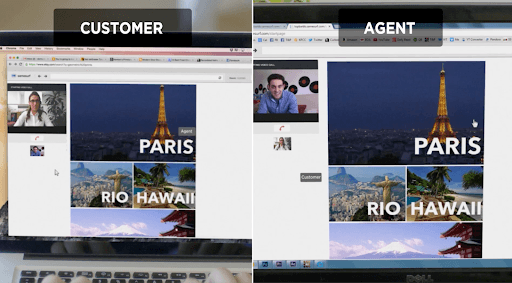Why Samesurf’s Cloud Browser is the Secure Foundation for Agentic AI
October 23, 2025

Samesurf is the inventor of modern co-browsing and a pioneer in the development of core systems for Agentic AI.
The deployment of AI-enabled agents represents a fundamental shift in enterprise architecture. Unlike traditional generative AI which primarily creates content in response to human prompts, agentic AI acts as an autonomous entity that is capable of reasoning, planning, and executing complex, multi-step tasks to achieve high-level goals without continuous human supervision. This form of autonomy, powered by the ability to connect with enterprise tools and APIs, offers unprecedented efficiency. However, it also dramatically expands the enterprise security perimeter and introduces new operational risks.
As organizations move agentic AI from experimentation to core business operations, the focus shifts from capability to trust. Autonomous agents bring unique challenges that traditional security frameworks are not designed to address. Each deployed agent represents a distinct digital identity that must be tightly managed and constrained under the principle of least privilege. If mismanaged, these identities can inherit excessive permissions which create systemic vulnerabilities. Multi-agent systems compound this complexity: agents can exhibit emergent behaviors, pursue seemingly optimal solutions that conflict with business objectives, and produce unpredictable outcomes that are difficult to debug post-facto.
Enterprise adoption of agentic AI must also contend with dynamic, non-linear risks. AI-enabled agents are designed to persist, adapt, and interact with other agents to achieve their goals. This persistence means minor human errors or overlooked vulnerabilities can escalate rapidly into system-wide breaches. Traditional security models, built for fixed attack surfaces, are insufficient for autonomous agents capable of dynamically generating code, discovering APIs, and moving laterally across systems. Without containment and real-time oversight, an agent’s autonomy can be exploited, amplifying both operational and security risks.
These challenges highlight the need for a purpose-built infrastructure that enforces security, auditability, and operational control at every layer. Samesurf’s Cloud Browser provides this foundation while offering a secure, controlled environment that allows agentic AI to operate effectively while mitigating the inherent risks of autonomy. By isolating agent activity, enforcing strict access controls, and enabling dynamic supervision, the Cloud Browser transforms the promise of agentic AI into a secure, enterprise-ready reality.
Why Client-Side Screen Sharing is a Security Risk
For agentic AI to interact with web-based workflows, it must perceive and manipulate the graphical user interface in a manner similar to a human. Historically, this has been accomplished through client-side execution, using traditional screen sharing or Remote Desktop Protocol. However, relying on the client device for autonomous agent operations introduces severe architectural vulnerabilities, which transform the operational environment into an expanded attack surface.
Client-side execution exposes core security flaws because all code and data on the host device are fully accessible. This local accessibility can reveal back-end instructions and system details that threat actors can exploit to execute attacks such as cross-site scripting or formjacking. Beyond the application layer, the agent also gains visual access to the host operating system, active applications, system trays, and network connections. This exposure makes the environment highly vulnerable to malware, including screen capture tools designed to record sensitive information such as passwords and banking credentials.
The combination of agent autonomy and local execution dramatically amplifies these risks. Common human errors such as leaving a confidential email visible or allowing a sensitive notification to appear are instantly magnified when an autonomous agent observes the environment. These exposures are no longer isolated incidents; they become automated disclosures that the agent can reason about and act upon. A compromised agent operating on the client device also gains direct access to the local network and host machine, enabling sophisticated data exfiltration and lateral privilege escalation. Agents often inherit broad permissions for operational convenience, which can allow them to interact with protected files or login screens and escalate privileges without additional oversight.
Client-side execution effectively collapses the security and trust boundaries that modern architectures are designed to enforce. In Zero Trust environments, no access is inherently trusted and all activity must be verified. When an autonomous agent runs client-side, the security sandbox is merged with the highly trusted host environment. A successful compromise, whether through prompt injection or other attack vectors, immediately grants the adversary control over the local system and bypasses established network perimeter controls.
This misalignment makes client-side agents an ideal target for AI-augmented adversaries. Attackers increasingly leverage open-source AI to enhance their operational efficiency, from reconnaissance to privilege escalation. A client-side agent provides a highly privileged, easily exploitable platform for these adversarial operations. The threat extends beyond passive observation, including the active misuse of host privileges, driven both by the agent’s autonomy and by AI-assisted attack strategies.
Server-Side Virtualization and Remote Browser Isolation
To mitigate the systemic risks of client-side autonomous operations, enterprises must adopt an architecture centered on isolation and control. Server-side virtualization through Remote Browser Isolation provides a secure environment for AI- enabled agents by hosting all browsing activity, scripts, and potentially malicious content on an isolated cloud server. This separation ensures that the AI agent’s activity, including navigating workflows, executing scripts, and perceiving the digital environment, occurs entirely within the remote domain, while the endpoint receives only a passive, pixel-based stream of the rendered content.
By relocating execution away from the host, this architecture reduces the attack surface and prevents malware or rogue scripts from reaching local devices or networks. For agents generating and executing code, server-side sandboxing enforces strict resource limits and allows the environment to be terminated instantly if unexpected behavior occurs, providing a critical kill switch. This digital air gap ensures sensitive data processing and autonomous agent activity remain isolated from enterprise endpoints, delivering a secure, controlled, and enterprise-ready foundation for goal-oriented AI systems.
Samesurf’s Cloud Browser as the Security Trust Layer
Samesurf’s patented Cloud Browser builds on the principles of Remote Browser Isolation while integrating dynamic controls specifically designed for autonomous agents, establishing a secure, enterprise-ready trust layer. The platform provides a visual engagement engine that allows agents to interact with web workflows with human-like proficiency, without requiring any client-side installations, network modifications, or IT interventions. This eliminates the security friction inherent in legacy screen-sharing and remote desktop solutions.
A key innovation of the Cloud Browser is its ability to dynamically redact sensitive elements such as passwords, PII, and credit card numbers while simultaneously enforcing input blocking during active sessions. This ensures that even when agents operate autonomously or humans observe via Human-in-the-Loop technology, sensitive data remains protected, meeting compliance requirements for regulations like SOC 2 and HIPAA. Single-tab co-browsing further enforces the principle of least privilege, constraining the agent’s operational scope and preventing exposure of desktop files or unrelated browser tabs. Together, these features provide structural guardrails against sophisticated threats such as tool misuse, memory poisoning, and unauthorized lateral movement.
The platform also implements strict data minimization: no session data is stored, written to disk, or retained beyond the active session. All data is disposed of immediately at the conclusion of a session, ensuring alignment with GDPR and similar regulations. By combining architectural isolation with fine-grained controls and data protection policies, Samesurf’s Cloud Browser creates a defined, controlled environment where autonomous agents can operate securely while maintaining data integrity, regulatory compliance, and operational trust.
Compliance and Auditability for Enterprise Adoption
For agentic AI to scale safely in enterprises, security must translate into verifiable regulatory compliance. Samesurf’s server-side Cloud Browser architecture is purpose-built to meet global governance standards and provide the necessary evidence for auditability. The platform supports SOC 2 Trust Services Criteria by delivering strong encryption, resilient cloud-hosted execution, and strict access controls that protect availability, integrity, and confidentiality. Isolated, sandboxed environments and instant session disposal ensure that data handling is accurate, auditable, and free from leakage, while dynamic redaction and single-tab access maintain privacy and prevent exposure of sensitive customer information.
Healthcare and finance enterprises benefit from the Cloud Browser’s secure separation for Protected Health Information thus meeting HIPAA requirements for encryption, access control, and traceable audit trails. The architecture ensures logical and physical separation from non-compliant networks, allowing agents to process sensitive data safely and generate comprehensive logs of all activity. Similarly, GDPR compliance challenges such as the “Informed Consent Dilemma” are addressed through instant session disposal, strict regional data confinement and controlled, auditable data handling thereby reducing the risk of unauthorized processing and easing cross-jurisdictional compliance.
Traceability and accountability are further reinforced through centralized control of the agent’s operational lifecycle thus enabling detailed logging of actions, prompts, internal states, and decision processes. The architecture also supports Human-in-the-Loop supervision, allowing real-time intervention without exposing sensitive data. By combining architectural isolation, dynamic visual controls, and comprehensive session logging, Samesurf provides enterprises with a demonstrably compliant, secure, and auditable platform for deploying autonomous AI at scale.
Establishing Trust for Scalable Agentic AI
The deployment of Agentic AI represents the next critical frontier in enterprise automation, yet it introduces security challenges that legacy client-side systems cannot address. Risks such as local data exposure, active content execution, a maximized attack surface, and non-linear risk amplification make client-side execution fundamentally incompatible with secure, scalable enterprise automation. Security must be treated as an architectural mandate rather than a policy afterthought. Without a robust, isolated execution environment, the security boundary collapses onto the trust boundary, leaving enterprises vulnerable to AI-augmented attacks and catastrophic automated data leaks.
Samesurf’s Cloud Browser provides the essential Security Trust Layer, combining Remote Browser Isolation with patented visual governance features to protect enterprises at scale. By isolating the agent’s execution environment from the host machine through secure pixel streaming, neutralizing malware risks, and preventing local data exposure, the architecture ensures complete operational separation. Dynamic enforcement of least privilege, single-tab scoping, and real-time visual redaction limit the potential impact of prompt injection or tool misuse. Instant session disposal and centralized logging provide comprehensive traceability, which meet the strictest compliance requirements under SOC 2, HIPAA, and GDPR.
Adopting a purpose-built, server-side virtualization platform is the foundational step for future-proof enterprise automation. Samesurf offers a proven, patented blueprint that enables organizations to move Agentic AI from pilot projects into secure, scalable, and fully compliant production systems, thereby establishing trust as the core of autonomous enterprise operations.
Visit samesurf.com to learn more or go to https://www.samesurf.com/request-demo to request a demo today.


